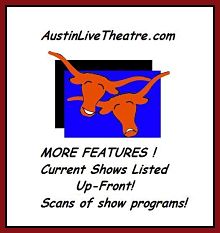 Last week NEA Chairman Rocco Landesman opened the conference on new plays at the Arena Stage, Washington, by challenging arts professionals to come to terms with the fact that a 2008 NEA study showed that audience numbers were falling while the number of non-profit arts organizations was surging. He set a tempest swirling in the theatre blogosphere.
Last week NEA Chairman Rocco Landesman opened the conference on new plays at the Arena Stage, Washington, by challenging arts professionals to come to terms with the fact that a 2008 NEA study showed that audience numbers were falling while the number of non-profit arts organizations was surging. He set a tempest swirling in the theatre blogosphere.
Landesman made further points in a blog post today, citing the Rude Mechs (presenting I Can't Believe I'm So Happy at the conference) and others as ensembles worthy of increased support. He said, in part, that he wanted to make two points:
Two. When I say that “decreasing supply” has to be on the table when talking about the future of not-for-profit arts organizations, in no way do I mean that that is the only thing that should be on the table. Here are some other things that I have lobbed out in conversations:
Increase arts education. We dove deeper into the SPPA data, and discovered that arts education is one of the only reliable predictors of future arts participation. Not age, race, ethnicity, or income level, but arts education. Exposure to the arts—early and often—builds future audiences.
Take advantage of related demand. As we are watching audiences at not-for-profit arts organizations shrink, we are seeing an explosion of demand for singing and dancing. Prime time network television is filled with Dancing With the Stars, American Idol, Glee, and So You Think You Can Dance. Should we dumb down what we are doing as a sector and ask J-Lo to be America’s cultural arbiter? Absolutely not. But to borrow a phrase from Bill Ivey, Americans are hungry for and will seek out an expressive life. Our not-for-profit arts organizations need to also be feeding that hunger with what we offer.
Offer free samples. I have just returned from the opening of the New World Symphony, which is broadcasting concerts for free on the outside of its building. The highest quality video and audio are allowing people to sample what happens inside the concert hall. It is not exactly the same thing as the grocery stores that offer free tastes of hickory-smoked sausage, but if you offer a taste of a high quality product, people will come back for more.
Technology is key in this: the NEA’s Audience 2.0: How Technology Influences Arts Participation shows that people who consume art via the Internet and electronic media are nearly three times as likely to attend live arts events, that they attend a greater number of live events, and that they also attend a greater variety of arts events.
Examine our arts infrastructure. There are 5.7 million arts workers in this country and two million artists. Do we need three administrators for every artist? Resident theaters in this country began as collectives of artists. They have become collectives of arts administrators. Do we need to consider becoming more lightly institutionalized in order to get more creativity to more audiences more often? It might also allow us to pay artists more.




No comments:
Post a Comment